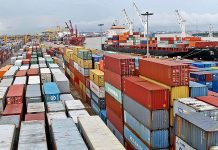
A shipping revolution is taking place with the digitalisation of the industry that will transform it, according to shipping experts, but this transformation, which was expected to be steady, has been accelerated by the ongoing pandemic.
Digital innovations are expected to play a crucial role in the coming years making the shipping industry more agile, flexible and easily adaptable to new environments and circumstances.
A digital transformation is under way, but so is a revolution in vessel power. Together the Digital Series and the Decarbonisation Campaign, with extended stories published on 15 and the last day of every month respectively, will track the transformation of the industry from its archaic practices to the modernised, flexible, clean and efficient future.
Even before the pandemic hit global trade, the two major pillars for the transformation of supply chains were clear, the digital age is upon us, but so too is the clean shipping era. For these reasons, we at Container News have decided to develop a Digital Series, which will look into the benefits, pitfalls and challenges of the digitalisation for the shipping industry.
Our digital campaign will last for the next nine months and will involve several sectors, which are expected to be impacted by new technologies, such as ports, terminals, liner operations, cybersecurity, shipping incidents as well as the processes used by companies to sell and allocate vessel capacity.

Developments in the maritime industry are generally steady, the sector considers itself to be conservative, not given to radical changes. That is why, despite important digital developments, “the connectivity of maritime assets is not comparable with speeds and latency experienced on land,” according to Marlink Maritime president, Tore Morten Olsen.
Olsen believes that we have to be patient, as “improvement will take time because the maritime sector comes from a legacy of customised, bespoke systems and only recently moved towards standardised systems and data formats.” When these standardised systems become more established, we will see an acceleration in the pace of digitalisation again, according to the Marlink president.
Emma Mark, the head of operations at Intelligent Cargo Systems, a technology shipping company, agrees with Olsen. “Shipping has, in the past, been viewed as a very traditional industry, with a tendency to maintain tried and tested ways of working without exploring ways to improve,” she told Container News adding, “Digitalisation and technological progression can only be a good thing for our industry, however, if there is internal resistance this can potentially cause issues for key stakeholders.”
A shift towards a more collaborative approach within the industry has “Questioned this mindset and created opportunities for technology companies to integrate their solutions into existing platforms. However, in order for digitalisation to really come into its own, all of the stakeholders need to be onboard and engaged, from crew to CEO’s,” explained Mark.
The movement from analogue to digital development was slowly progressing pre-pandemic as digital innovation was reluctantly considered by those in the maritime sector. However, the pandemic has worked like a shot of adrenalin to maritime’s digitally idling developers.

Florian Freese, marketing lead at Container xChange, a container logistics solutions provider, argues, “Obviously, we are not satisfied as there are still numerous lengthy processes that could be done more efficiently, but we see the entire industry moving in the right direction,” adding, “digitalisation is a development that takes many years and a process that will never be completed.”
However, with the Covid-19 shot in the arm, technological developments have accelerated because companies have been forced to find innovative ways to maintain their operations. “Digitalisation has been crucial for the continuity of the maritime supply chain during the pandemic,” pointed out United Nations Conference on Trade and Development (UNCTAD) in its “Covid-19 and maritime transport: Impact and responses” report.
Port Community Systems (PCS), Single Windows (SW) and other electronic exchange platforms, for example, have played a critical role during the Covid-19 crisis, according to UNCTAD, which noted that digital infrastructure has facilitated trade and cross border logistics by simplifying administrative and regulatory processes.
The UN body pointed out that paperless procedures were introduced to calls for several types of digital advances, such as cybersecurity and the sharing of information. UNCTAD explains that maritime transport is undergoing a technological transformation with high support for dematerialised processes and calls for “more online remote procedures to be included” and for “improvements in terms of transparency and flexible supply chains to allow change based on real-time events and impacts”.
There have also been calls for “better manpower management systems”, “enhancement of Information Technology (IT) capabilities”, “integration of more digitised and paperless workflows”, and “the introduction of automation”, according to UNCTAD, which describes the industry transformation as “multidimensional”, and is expected to include remote planning and managing both administrative and operational tasks.

“Covid-19 has clearly highlighted and indeed has actively accelerated the need for remote real-time visibility, monitoring and control technologies as critical ‘pieces of the puzzle’ for digital transformation in container shipping, ports and landside logistics,” Al Tama, ORBCOMM’s vice president and general manager, Container and Port Solutions, told Container News.
In particular, ports have noted that the use of technology intensified as a means of addressing some of the new challenges. For example, “new web and mobile phone-based release booking systems have been adopted in major container terminals,” noted UNCTAD in its report.
Several companies in the industry forecast most technological changes that Covid-19 has caused or accelerated will remain and will be useful tools even after the pandemic period.
According to the Port Authority of Valencia, Port Community Systems integration along the supply chain will be a trend to follow in order to foster resilience and innovation based on the 4.0 technologies, a key element for competitiveness in a scarce traffic environment. The Spanish port has decided to launch a new “Strategic Plan” in order to be ready in the post-pandemic period, when a new reality will be revealed, which, the port believes, will entail more digital, innovative, responsible, carbon neutral and resilient ports.
Shipping lines, like ports, are shifting toward a technological age, acknowledging that digitalisation has a crucial role to play in managing and controlling the pandemic period and that new technology will continue to be key in the post-Covid era.
Robbert vat Trooijen, the head of Latin America and the Caribbean at the world’s largest container line, Maersk, mentioned during the virtual TOC Americas 2020 conference that digitalisation is the main reason that the industry has managed to achieve the performance levels it has during the Covid-19 crisis. Meanwhile, Maersk’s 2M Alliance partner, Mediterranean Shipping Company (MSC) stated, “it is realistic to expect a slow recovery from the pandemic, considering the major hit that the global economy has taken but that technologies will play a crucial part.”
The need for technological improvements was echoed by a large number of respondents to a survey designed to measure the effect of the coronavirus pandemic on global supply chains, which was sponsored by data analysts Ocean Insights.
The vast majority (67.3%) of the respondents to the survey, who numbered more than 300 shipping and freight professionals, indicated that these changes referred to investments in technology, while investments in employees, assets, acquisitions and other aspects were selected by 33%, 26.2%, 13.6% and 12.2% respectively. The survey’s results show emphatically that, at the moment, the technology sector constitutes the top priority for the shipping industry.
One of the main technology sectors that an increasing number of shipping companies want to invest in and explore is blockchain. Recently, we have seen several blockchain shipping projects that aim to improve the efficiency of the shipping processes and improve the industry’s operations. One of the most important ones is TradeLens, a blockchain-based supply chain platform jointly developed by Maersk and IBM, which aims to enable true information sharing and collaboration across supply chains, thereby increasing industry innovation, reducing trade friction and ultimately promoting more global trade.
There are two viable alternatives for blockchain in shipping to foster peer-2-peer collaboration, according to Florian Freese from Container xChange. Firstly, you can always set-up bilateral Application Programming Interfaces (API) if you already know your partner very well and just want to improve efficiency in collaboration. And secondly, in cases where bilateral trust is not there yet, companies can join neutral platforms or clearing houses that are operated by a trusted third party.

“These platforms can then make sure that transactions are secured, and network members can trust each other. Moreover, they can also improve efficiencies through paperless document transfer or easy to use payment handling even without educating yourself on the underlying technology itself,” commented Freese.
In theory, the benefit of this technology is that it can enhance transparency and increase trust between stakeholders, said Olsen, who also noted that “shipping is one of the most interesting and exciting sectors for blockchain implementation due to the complexity of the trade chain process.” He added, “issues such as energy efficiency and decarbonisation also have a potential to increase safety and profitability, providing that transparency extends to all stakeholders.”
But Olsen has pointed out that blockchain initiatives have to overcome several challenges in order to be useful and efficient in the shipping industry. This new technology was sold like a dotcom boom solution, but the lessons learned are that to implement and make it commercial are much more challenging in practice.
“A lot of start-ups shut down before they are able to create value for the industry, but now a more collaborative approach is emerging to transparency and trust in the logistics chain,” said Olsen, who concluded that “it seems that rather than shipping adapting to Blockchain, Blockchain is adapting to the industry.”
Freese has also expressed his concerns on the current level of blockchain adaptability to the shipping industry. “Although blockchain is often the best option for creating trust, traditional technologies are still the right choice for transactions and processes that involve a small number of parties who already know each other or for whom it is easy to establish a single, indisputable source of truth,” he told Container News.
With the significant technology developments in shipping, a need for an industry digitalisation framework was raised. In 2019, the Digital Container Shipping Association (DCSA) was established by several of the largest container shipping companies with a mission to shape the digital future of container shipping by being the industry’s collective voice, working towards alignment and standardisation.
“By setting frameworks for effective, universally adoptable solutions and innovating, we can enable transparent, reliable, easy to use, secure and environmentally friendly container transportation services,” the non-profit association claims.
DCSA’s open-source standards, free for everyone to use, are developed based on input from DCSA member carriers, industry stakeholders and technology experts from other industries.
“At DCSA, we envisage a digitally interconnected container shipping industry in which customers have a choice of seamless, easy-to-use services that provide the flexibility to meet their business and sustainability goals,” says the association, which includes Maersk, MSC, CMA CGM, Evergreen, ONE, Hapag-Lloyd, Yang Ming, HMM and ZIM.
Al Tama from ORBCOMM believes that standardisation actions will support the shipping industry to take its next steps toward the technology transformation. “Standardisation efforts by bodies such as the DCSA and the United Nations Centre for Trade Facilitation and Electronic Business (UN/CEFACT) have focused heavily on shipment data and tracking technology and are helping push the industry toward digitalisation,” he highlighted.

At this time the demands for greater efficiency will increase the scope of digital operations and the corona crisis has accelerated several technology projects, it is crucial to mention that the first peak of the Covid-19 outbreak witnessed another unpalatable peak in cyberattacks on shipping and a wider increase in digital scams and criminal activity, according to James Collett, managing director of Sperry Marine, a maritime navigation solutions provider.
The industry is forced to take actions against these threats. “Shipping companies must address cyber security under the International Safety Management (ISM) Code in order to meet International Maritime Organization (IMO) 2021 regulations with which all ships must comply,” argued Collett who went on to add, “The amendment to the ISM Code requires operators to have addressed cyber security in their safety management systems, in particular the extent to which hardware and software are up to date and they can demonstrate they have a cyber resilience plan in place.”
In addition to increasing regulation such as the IMO2021 rules, the other driver to better procedures and practices is “charterer requirements for greater transparency,” according to Olsen, who believes that this is causing “a mindset change for shipowners in considering the risks and the mitigation requirements.”
Furthermore, Olsen argues that cyber attackers are becoming more sophisticated, so the protection will have to be more sophisticated too, encompassing digital and physical surveillance. “The digitalisation process will connect more and more assets and produce eventually more sources of data and as a result it enables smarter and better surveillance which again will increase safety,” he noted.
Moreover, cybersecurity is expected to play a crucial role in the operations of the automated ships of the future, which will use satellite technology. This kind of technology is currently improving and becoming significantly more affordable for several maritime issues such as the monitoring of and protection of perishable cargoes in Internet of Things (IoT) enabled reefer containers.
“Satellite communications have played a crucial part in global container operations for decades now,” according to ORBCOMM, which told Container News that “Satellite Automatic Identification System (AIS) to track vessels across the globe has long been integral to the safety and regulatory compliance of world shipping.”
Vessel satellite AIS data is now being used for a range of other purposes, other than the use it was originally envisaged, including supply chain visibility, commodities trading, environmental management, operational efficiency, business intelligence, with vessel automation and more to come.
According to ORBCOMM, satellite technology is also used for on-land container IoT operations in demanding regions. An example is the New Silk Road, where satellite IoT devices are safeguarding containers and their cargo as they move many thousands of miles from Asia to Europe crossing very harsh climates and sparsely populated areas where it is vital to have an “eye in the sky”.
ORBCOMM believes the next generation of satellite technology will enable and enhance container industry digitalisation by supporting IoT track, trace and remote control around the globe, reaching parts of the world – both oceans and land – that are not easily connected by the current networks.
There are many proposed pathways towards smarter shipping, according to Collett, including greater use of automation and increasing the deployment of connectivity and processing power to “the edge” on the ship and ultimately, some degree of autonomy.
“What the last year has demonstrated beyond doubt is that before that end point, a lot of what we need can be achieved using remote access for inspection and verification trouble shooting and problem-solving,” argued Collet, who also pointed out that, “The remote business model has arrived in shipping and it’s a trend that must be embraced – though it does not mean that humans are out of the loop.”
Container News understands that the combination and interaction of man and machine will be the key to the improvement of shipping operations in terms of safety and sustainability in the coming decade. The proper defining of each part’s scope of responsibility can make this relationship work, increasing the efficiency of the whole industry’s operations and processes.
Collett suggests that “tasks and actions that have little value for humans should be automated and those where human skills and knowledge will always be superior should see technology support the decision process not supersede it.”
Digitalisation has already infiltrated the shipping industry, but we are still in the first stages of this new reality. The industry’s experts and decision-makers will have to find the proper way to combine new technology developments with the traditional, tried and true methods in order to maximise the potential benefits.
“A sustainable shipping industry requires the marriage of safety and technology, combining human skills and with true aids to navigation,” stated James Collett, who emphasised in a Sperry Marine’s announcement that “What the industry must remember is that, even as we come closer to a ‘post-Covid’ economy, digital transformation is a process that we are closer to the start of than the end.”








